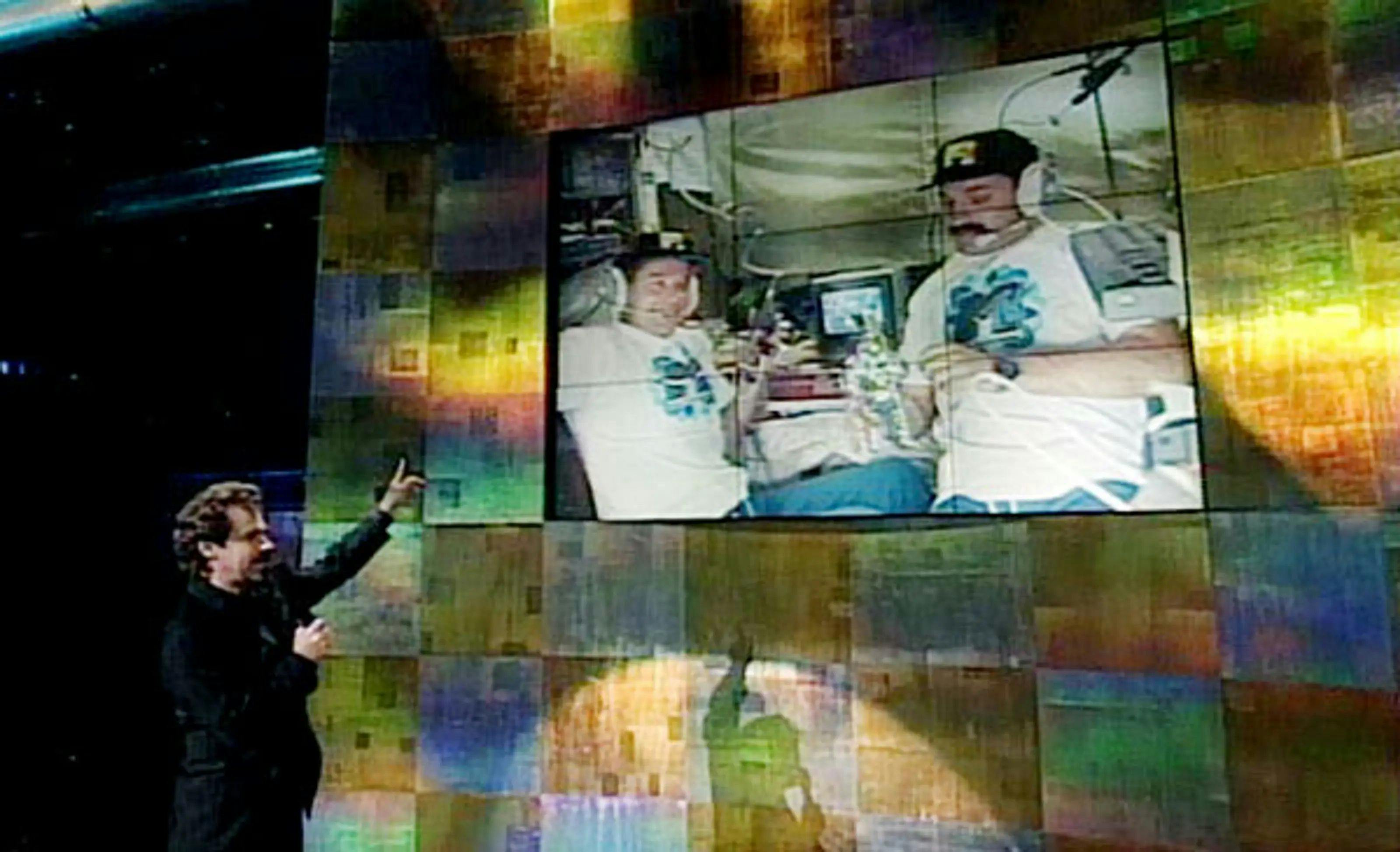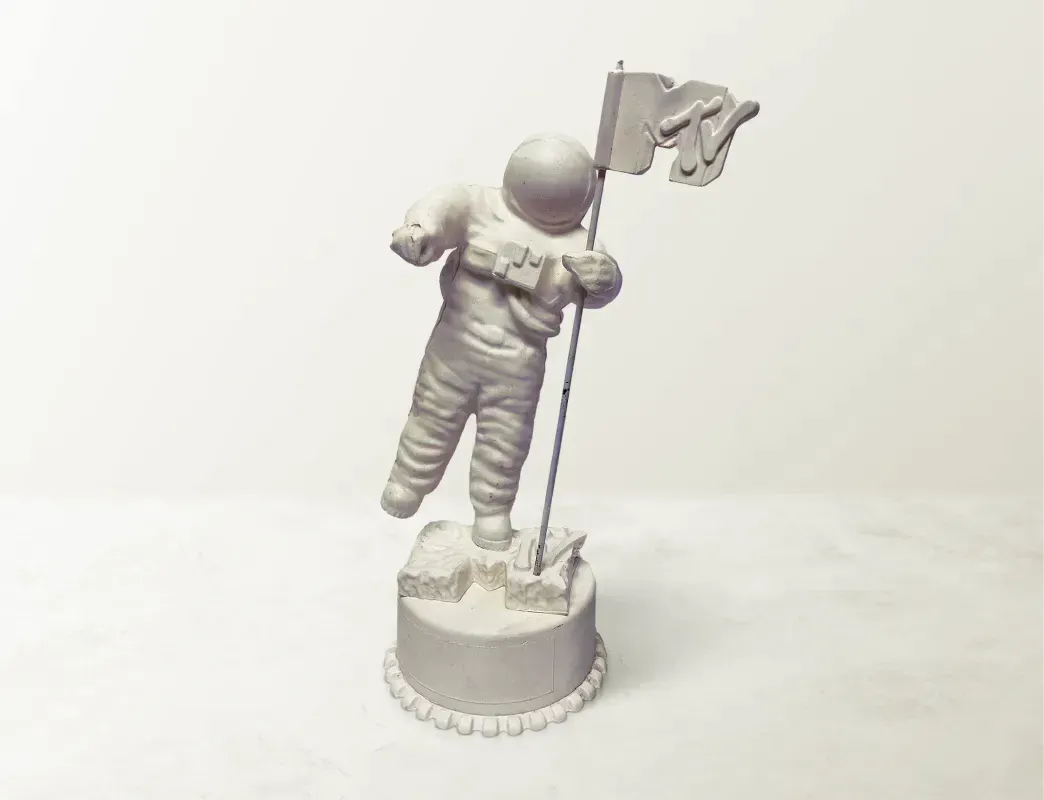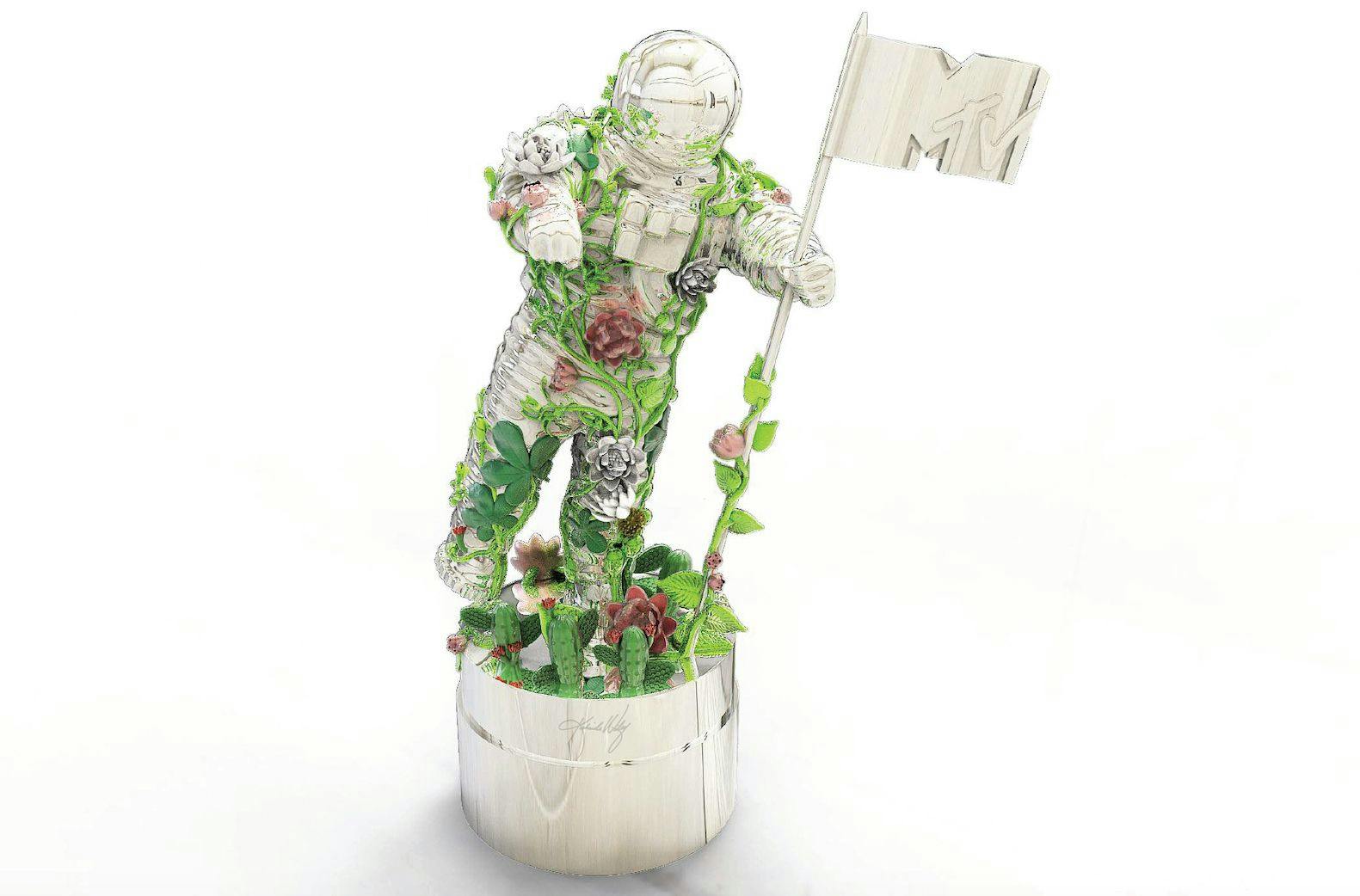MTV: I Dream in Music Video


The most iconic image of the Apollo 11 moon landing is, surprisingly, an incidental self-portrait. The subject is not Commander Neil Armstrong—as one might expect—but rather Buzz Aldrin. Armstrong told him to “stop right there” for the spontaneous photo; Aldrin’s arm is mid-swing as he turns to face Armstrong’s 70mm lunar surface camera. His helmet is so gleamingly reflective that the long shadow of Armstrong’s body—and the pitch-black expanse of space behind him—is completely clear: the photo features two explorers, two sets of feet newly planted on the moon, two unknown horizons. Yet the star of one of the world’s most recognizable images, the prototypical astronaut, is a man whose research in the field of space rendezvous helped propel Apollo 11 to the moon in the first place. The MTV Video Music Awards (VMAs) Moonperson, a trophy inspired by this photograph, is modeled not after the first man on the moon, but the second.

1984 MTV Award prototype designed by Pat Gorman and Manhattan Design
The Moonperson—formerly known as the Moonman—was created by Manhattan Design, a New York-based design collective, and sculpted by the studio’s co-founder Pat Gorman for MTV’s first VMA show in 1984. The astronaut plants an MTV logo-shaped flag, an action sending them afloat, with one foot mid-bounce and the other firmly secured to the base. That base appears at times M-shaped, craggy, or smooth, depending on the year; the flag swivels, as if it were billowing. The Moonperson fits into the broader visual language that Manhattan Design had already developed for MTV, including the bold “M” logo, overlaid with a spray paint-scrawled “TV,” and the iconic “Top of the Hour” clip which MTV debuted in 1981 and would proceed to air on the hour, every hour, for the next several years. The clip featured the Apollo 11 launch followed, of course, by the fixing of the MTV flag on the moon, then a voiceover by MTV co-creator John Lack, stating, “Ladies and gentlemen, rock ‘n’ roll.” Cue the guitar riffs of the network’s first theme song. The clip was pulled in early 1986 following the Challenger disaster, but the Moonman was emblazoned into the collective consciousness—forever stepping toward the future.
There is a long history of music television prior to the advent of the music television: Warner Brothers’s live-action musical shorts, “Spooney Melodies” (1930-1931); Queen’s “Bohemian Rhapsody” (1975); David Bowie’s performance of “Starman” for Top of the Pops (1972); Soul Train. But the VMAs introduced the uniquely competitive parameters of an award ceremony; with this, the medium would flourish. The title of the acquisition round that ushered the Moonman prototype into Arkive’s collection, “Electric Dreams,” is just right, given the parallels between those two seminally transformative moments—the dual launches of Apollo 11 and MTV. Music television was a collective fantasy, a dream made real. What magic would this still-new art form inspire—what worlds would it create? Here is something I’ve never put to paper: I daydream in music video. In transit, closing my eyes for a nap, zoned out between meetings—invariably plugged into headphones, music prompts for me fantasies of the banal-made-joyous: a weekday in which the stars have aligned and my loved ones are all in the same city, or my cold pitch gets a confirmed yes, or I am, momentarily, worry-free.
Perhaps MTV helped build the patterns of my consciousness, shaping my relationship to music and rendering it a visual experience. As a child of the ’90s and early aughts, MTV was a decent babysitter. In the inevitable loneliness of the late evening and the nervous morning hours before school, music videos were transportive respites, however brief. My memories are punctuated with musical imagery: Mase and P. Diddy shining and distorted in fish-eye; the aquatic summer camp make-out of Mariah Carey’s “Always Be My Baby.” The faux-news broadcast that described the dangerous killer bees in Wu-Tang Clan’s “Triumph,” the surreal cartoon romance of A-Ha’s “Take On Me.” “Candy Rain”’s tinsel and cashmere, Missy Elliott’s patent-leather blowup suit. Consider the niches created for and by directors like Hype Williams, Melina Matsoukas, Dave Meyers, Spike Jonze—all of whom have received Moonpersons—or the trajectory from the dance break of Michael Jackson’s “Thriller” to the videos comprising BTS’s BTS Universe series, an alternative dimension in which each video fulfills a chapter in a Jungian narrative. My childhood recollections are the happy consequence of the Moonperson. While music videos were a turning point, the award symbolized their validation, the establishment of a proverbial yardstick by which to measure a musician’s ability to hold our attention via their cinematic vision—a vision that would inevitably touch and influence those of us who were just watching.

Dennis Miller has a conversation with astronauts at the Russian MIR Space Station, making this the first awards show to conquer space. Photo by MTV.
The VMAs have changed, and so has the Moonperson. In 2013, KAWS designed a trophy with his signature X-eyes and an accompanying giant, inflatable version for the stage. Two years later, Jeremy Scott gave it an overhaul with rainbow tones, winged sneakers, and a peace-sign necklace. In 2017, in an announcement by network president Chris McCarthy, the Moonman became the gender-neutral Moonperson. “Why should it be a man?” McCarthy said, in an interview with The New York Times. “It could be a man, it could be a woman, it could be transgender, it could be nonconformist.” In 2021, for the occasion of MTV’s 40th anniversary and in a collaborative effort with The Society Project, Kehinde Wiley designed a vine-and-flora-covered Moonperson, each leaf representing the African and Indigenous roots of US history. In 2022, a giant Moonperson featuring, horrifyingly, Johnny Depp’s video-imposed face, floated above the audience. Unlike the Grammys, the VMAs encourage informality and spectacle—it was on MTV’s stage where Britney kissed Madonna, Kanye West intercepted Taylor Swift, and Fiona Apple declared, comfortingly, “This world is bullshit.” In 1996, a Moonperson was sent to the Russian space station, Mir (sans base to lighten the load) at the behest of MTV’s client, Pepsi. Host Dennis Miller spoke with the cosmonauts via satellite, to awkward effect—the connection was spotty. The first video MTV ever aired was The Buggles’s “Video Killed the Radio Star,” both a declaration and a tongue-in-cheek joke.
The understanding that music videos are a precursor to our digital world, in which technology has become life itself, is apt. It’s a future Gorman and the rest of Manhattan Design likely predicted. Why else would they equate MTV—a channel now known more for reality TV—with the final frontier? None of us, however, might’ve predicted the scale or the attendant, abysmal drive for visually arresting “content.” For the average video, our attention is required for a few minutes, but today’s attention economy demands all of it, more and more, and artists are forced to compete for mere nanoseconds. Surprisingly, while the strategies to achieve this might continue to shift, the feeling of a video being good–stylish, compelling, memorable—is unchanging. Coolness is a forever phenomenon.

Kehinde Wiley's MTV Moon Person. Photo by MTV.
I recently stumbled on the TikTok account for Scarlet Foxes, a floppy-haired musical duo known for a clip in which they lip-sync to Tears For Fears’s “Everybody Wants to Rule the World.” The video opens with one of them hopping from foot to foot, their body tilted ninety degrees; the singer literally slides into the frame, then twirls. The camera never stops moving. Another TikTok creator, @joeydeanofficial, assesses the clip’s pull in a video titled “WHY THIS WENT VIRAL: ADVICE FOR MUSICIANS” with the following three points: your scrolling is interrupted by the unique introduction, the constant movement means you won’t swipe away, and the duo’s style and aesthetic are immediately clear. Musical trends on TikTok are some of the app’s most ubiquitous, and artists are challenged by some of the same questions that, perhaps, Tears For Fears were asking themselves in 1985. As of this writing, the rap duo Flyana Boss continue to promote their song "You Wish" on TikTok by singing two of the track's catchiest verses while running through various settings—Disneyland, a grocery store, Google's office. It’s arresting and adorable; call it a gimmick, but by the time they go on tour, you'll know the song by heart. Still so informed by the aesthetic sensibilities of my upbringing, I rarely send an audio track to ensure that my friends fall in love with my favorite songs. If they’re able to see, I include the accompanying video—and if they’re not, I still attach the song that was good enough, representative enough, to be alchemized into a music video in the first place. The songs that demand a story be told multitudinously: those are the ones steadily on repeat, the ones that stay with me forever.